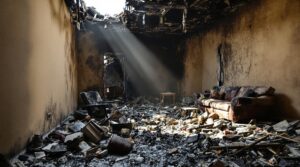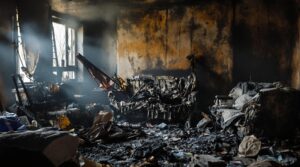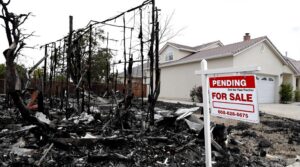Fire insurance policies offer diverse coverage options to protect property owners from financial losses. Policies include thorough, replacement, valued, and average policies, catering to various needs and risks. Replacement-cost coverage reimburses the full cost of replacing damaged property, while actual cash value reimbursement considers depreciation.
Fire insurance policies may also cover additional perils, such as theft and natural disasters. Exploring the various policy types and coverage options can help individuals make informed decisions about their insurance needs.
Key Takeaways
- Fire insurance policies come in various types, including thorough, replacement, valued, and average policies, catering to different property owner needs.
- Coverage options typically include damage to the physical structure, personal property, and Additional Living Expenses (ALE) for temporary accommodations.
- Replacement-cost coverage reimburses the full cost of replacing damaged property, while actual cash value considers depreciation in compensation.
- Policies may offer additional protections for theft, burglary, natural calamities, explosion damage, and allied risks like landslides and riots.
- When choosing a policy, key considerations include assessing property values, reviewing exclusions, and evaluating the claims process and timeline.
Types Of Fire Insurance Policies Available

Fire insurance policies are diverse and cater to various needs, offering property owners a range of protection options. The types of fire insurance policies available include thorough, replacement, valued, and average policies. A thorough policy provides extensive coverage against multiple perils beyond fire, such as theft, natural disasters, and explosions.
In contrast, a replacement policy covers the full replacement cost of damaged items without factoring in depreciation. A valued policy offers a pre-determined payout agreed upon at the time of purchase, regardless of the current market value of the insured property after a loss occurs.
An average policy penalizes under-insurance by adjusting compensation based on the actual value of the property at the time of loss. Each policy type has distinct features, allowing property owners to choose the most suitable coverage. The right policy guarantees adequate protection and compensation during a loss.
Understanding Replacement-Cost Coverage Vs. Actual Cash Value Reimbursement
When evaluating insurance coverage options, how do replacement-cost coverage and actual cash value reimbursement differ in providing compensation for losses? Replacement-cost coverage reimburses policyholders for the full cost of replacing damaged property with new items of similar kind and quality, without considering depreciation. In contrast, actual cash value reimbursement calculates compensation based on the replacement cost minus depreciation, reflecting the item’s current market value at the time of loss.
A thorough coverage plan typically includes choosing between these two types of reimbursement. While replacement-cost coverage often results in higher premiums, it provides a more extensive financial benefit in the event of a loss. An insurance policy that includes replacement-cost coverage will cover the full replacement value of an item, whereas actual cash value coverage will only reimburse the depreciated value. It is essential to consider the differences carefully when selecting an insurance policy. Public insurance adjusters can assist homeowners in navigating complex claims to ensure fair compensation under either type of coverage.
Additional Protections Against Other Perils
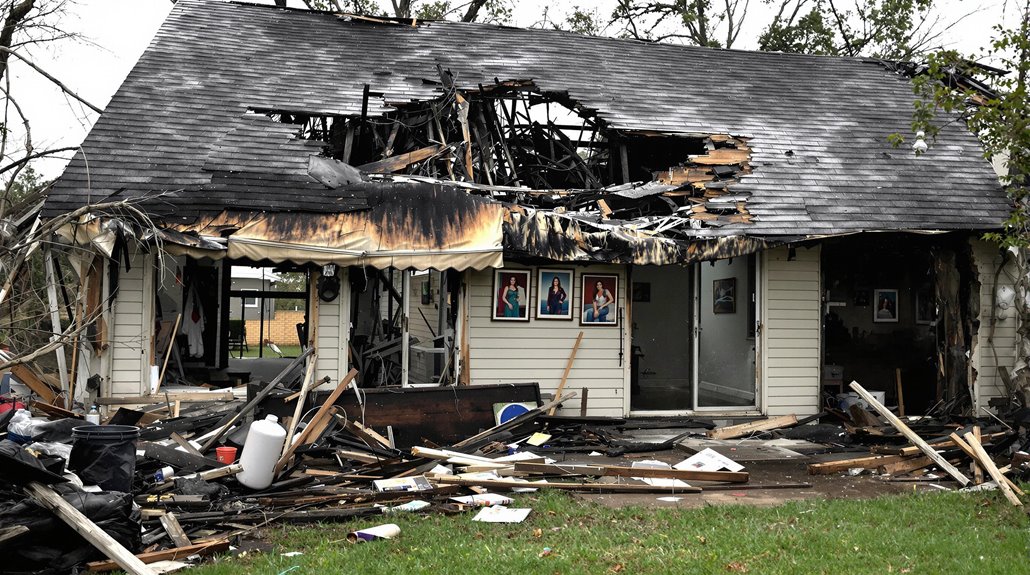
Numerous fire insurance policies offer coverage beyond mere fire damage to include a range of additional perils, ultimately providing property owners with broad protection. This thorough protection encompasses various risks associated with fire outbreaks, such as explosions and natural disasters.
Key aspects of additional protections against other perils in fire insurance policies include:
- Coverage for theft, burglary, and natural calamities like storms and floods, providing property owners with protection beyond just fire damage
- Inclusion of explosion damage and losses caused by thunderstorms, ensuring policyholders are safeguarded against various risks
- Broad coverage for allied risks, such as landslides and riots, is typically found in the Standard Fire and Allied Perils Policy (SFSP)
- Protection against accidental damage and vandalism through thorough fire insurance
- Exclusions for damages due to earthquakes or nuclear risks highlight the need for additional riders or separate policies for thorough protection against these specific perils.
Fire Insurance Coverage Options For Homeowners
Homeowners seeking thorough protection for their property can benefit from understanding the various fire insurance coverage options available to them. Fire insurance coverage typically encompasses damage to the home’s physical structure, including repairs to walls, roofs, and foundations impacted by fire incidents.
In addition to structural damage, homeowners insurance coverage also includes personal property coverage for items such as furniture, electronics, and clothing damaged or lost due to fire. Consulting with state-licensed public adjusters can significantly increase the likelihood of receiving fair compensation during the claims process. Many policies also provide Additional Living Expenses (ALE) coverage, offering financial support for temporary accommodations and increased living costs when the home becomes uninhabitable due to fire damage.
To guarantee adequate protection, homeowners should prioritize reviewing and updating their coverage regularly to reflect the current market value of their home and its contents, thereby avoiding underinsurance and significant financial losses during a claim. This proactive approach enables homeowners to maintain suitable fire insurance coverage for their property.
Key Considerations When Choosing A Fire Insurance Policy
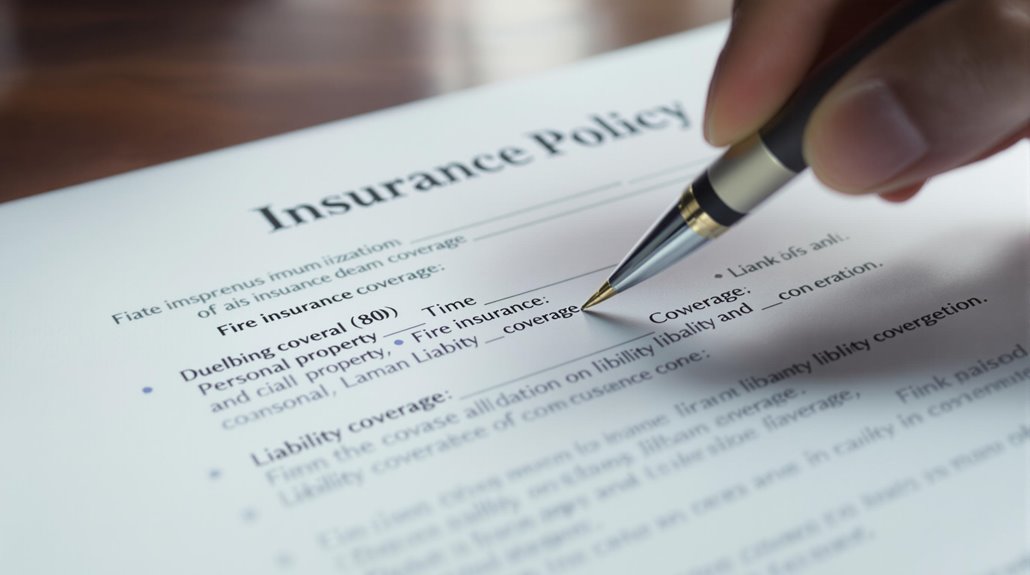
How can one navigate the complexities of selecting a suitable fire insurance policy? To guarantee adequate protection, several key considerations must be taken into account.
When choosing a fire insurance policy, the following factors should be carefully evaluated:
- Assess the value of your property and assets to determine the appropriate coverage amount, guaranteeing it aligns with your needs and protects against under-insurance penalties.
- Review the exclusions in fire insurance policies carefully, as many do not cover damages resulting from intentional acts or specific perils unless included.
- Evaluate the claims process and timeline associated with different insurance providers.
- Determine whether you need Additional Living Expenses (ALE) coverage to support temporary living arrangements while your home is being repaired after a fire incident.
- Consider the specific risks associated with your location to select a policy that offers additional coverage beyond fire damage.
Determining Coverage Limits Based On Property Value
When determining coverage limits for fire insurance, the current market value of the property serves as an vital benchmark to secure adequate protection against potential losses. Insurers recommend reviewing property values annually to adjust coverage limits accordingly, reflecting any property appreciation or depreciation changes. This guarantees that the insurance policy provides extensive coverage for the property’s replacement cost or actual cash value.
Failure to update coverage limits can result in underinsured properties, which may face penalties in claims payouts. To avoid coverage gaps, it is crucial to evaluate the value of additional structures on the property, such as garages or sheds, when determining overall coverage limits. By regularly appraising property values and adjusting coverage limits, homeowners can ascertain their insurance policy provides adequate protection against fire-related losses.
Accurate coverage limits enable homeowners to recover quickly and effectively during a fire. Consider working with independent insurance agents to calculate accurate replacement costs for local construction costs and building code requirements.
Understanding Coverage Inclusions & Exclusions
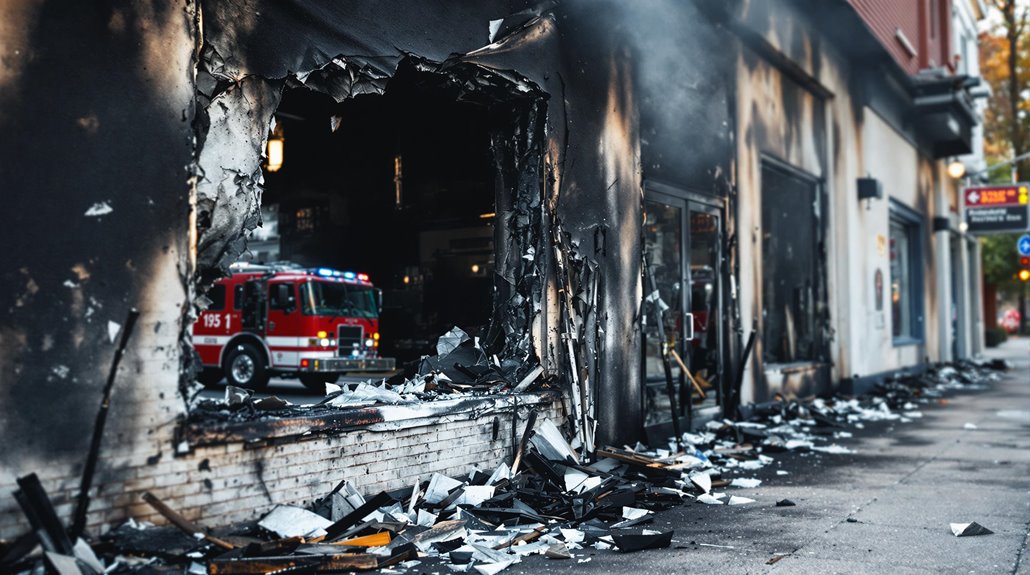
Fire insurance policies encompass a range of coverage inclusions that provide financial protection against losses resulting from fire damage. Understanding these inclusions, as well as policy exclusions, is essential for homeowners seeking thorough protection.
Key aspects of fire insurance coverage include:
- Physical loss or damage to the home’s structure and personal belongings directly caused by fire
- Additional Living Expenses (ALE) for temporary accommodations and increased living costs when the home is uninhabitable
- Related perils such as explosions, lightning, and storms
- Standard policy limitations for high-value items, which may require a Schedule of Loss for reimbursement
- Specific exclusions, such as damage from earthquakes and intentional acts, which may necessitate additional coverage options
Homeowners should carefully review their fire insurance policy to clearly understand coverage limits, exclusions, and the need for supplementary protections. This knowledge enables informed decision-making and ideal protection against fire-related losses.
Optional Add-On Covers For Fire Insurance Policies
Beyond the standard coverage inclusions and exclusions, homeowners may find it beneficial to contemplate optional add-on covers for their fire insurance policies to enhance their protection further. Optional add-on covers provide supplementary security, enabling policyholders to tailor their coverage according to their specific requirements.
Some notable options include consequential loss coverage and compensating for income loss from operational interruptions after a fire incident. Extended coverage options, such as protection for valuable items, guarantee adequate compensation in case of damage. Additional living expenses (ALE) coverage can also be added, helping policyholders afford temporary accommodations while their home is being repaired.
Furthermore, coverage for theft and burglary is available, offering security for property beyond fire-related damages. By opting for these add-ons, homeowners can guarantee extensive asset protection and mitigate the risk of unforeseen expenses. Careful consideration of these options is essential to maximize the benefits of fire insurance coverage.
The Fire Insurance Claim Process: What To Expect

How does one navigate the complex process of filing a fire insurance claim? Initiating the claim process begins with promptly notifying the insurer about the incident and providing documentation of damages and losses incurred. A thorough understanding of the specific terms of the insurance policy, including coverage limits and exclusions, is crucial to guarantee a successful claim outcome.
Key aspects of the fire insurance claim process include:
- Promptly notifying the insurer about the incident and providing documentation of damages and losses incurred
- Providing essential documentation, such as photographs of the damage, a detailed list of affected property, and relevant receipts or invoices for repairs or replacements
- Insurer-conducted investigations to assess the validity of the claim
- Timely submission of the claim to avoid impacting the approval process and compensation received
- Reviewing the insurance policy to understand coverage limits, exclusions, and the overall claims process for fire insurance claims.
Consulting with a public insurance adjuster can provide valuable expertise in navigating complex policy terms and maximizing settlement amounts for your fire damage claim.
Choosing The Right Fire Insurance Policy For Your Needs
When protecting one’s property, selecting an appropriate fire insurance policy is a significant decision that requires careful consideration of various factors—evaluating the property type, whether residential or commercial, is essential in determining coverage needs.
The value of assets must also be analyzed to decide between a valued policy, which offers a fixed payout, and an average policy, which considers market value. Comprehensive policies that cover multiple perils, including fire damage, can provide broader protection against unforeseen risks.
Examining exclusions in potential policies, such as coverage limitations for natural disasters or intentional acts is essential. Reviewing additional living expenses (ALE), coverage is critical, especially if temporary housing is needed during repairs. By carefully evaluating these factors, individuals can choose a fire insurance policy that meets their needs and provides adequate protection against losses.
Coverage needs should be regularly reviewed and adjusted. Standard policy components include dwelling coverage, other structures protection, personal property coverage, and liability protection for a well-rounded insurance plan.
Final Thoughts
In summary, thoroughly understanding fire insurance coverage options empowers homeowners to make informed decisions about their property’s protection. As the adage goes, “An ounce of prevention is worth a pound of cure,” a well-chosen fire insurance policy can mitigate devastating losses. By considering various policy types, coverage options, and add-ons, homeowners can devise a tailored plan that guarantees financial security in the face of disasters, ultimately safeguarding their property and peace of mind.
Frequently Asked Questions
What Are the Different Types of Fire Insurance Policies?
Fire insurance policies include Valued, Average, Extensive, Floating, and Replacement. Each provides distinct coverage, ranging from fixed payouts to multiple-peril coverage and replacement costs, catering to diverse property protection needs and ownership circumstances.
What Are the 4 Recommended Types of Insurance?
The four recommended types of insurance include a Valued Policy, providing a fixed payout; an Inclusive Policy, offering extensive coverage; a Replacement Policy, ensuring asset replacement; and a Floating Policy, covering multiple locations under one agreement.
What Are the 3 Basic Levels of Coverage That Exist for Homeowners Insurance?
Three primary levels of coverage exist for homeowners insurance, encompassing Actual Cash Value, Replacement Cost, and Extended Replacement Cost coverages, each providing distinct benefits and reimbursement structures to accommodate divergent property values and policyholder needs.
What Are the 12 Perils of a Standard Fire Insurance Policy?
A standard fire insurance policy encompasses 12 perils, including fire, lightning, explosion, smoke damage, aircraft and vehicle damage, vandalism, malicious mischief, riots, civil commotion, theft, storms, and electrical damage, providing extensive protection against various risks.

